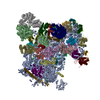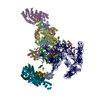[English] 日本語
 Yorodumi
Yorodumi- PDB-4uer: 40S-eIF1-eIF1A-eIF3-eIF3j translation initiation complex from Lac... -
+ Open data
Open data
- Basic information
Basic information
| Entry | Database: PDB / ID: 4uer | ||||||||||||
|---|---|---|---|---|---|---|---|---|---|---|---|---|---|
| Title | 40S-eIF1-eIF1A-eIF3-eIF3j translation initiation complex from Lachancea kluyveri | ||||||||||||
 Components Components |
| ||||||||||||
 Keywords Keywords | TRANSLATION / EIF3 / TRANSLATION INITIATION | ||||||||||||
| Function / homology |  Function and homology information Function and homology informationeukaryotic translation initiation factor 3 complex, eIF3e / eukaryotic translation initiation factor 3 complex, eIF3m / translation reinitiation / formation of cytoplasmic translation initiation complex / eukaryotic translation initiation factor 3 complex / multi-eIF complex / eukaryotic 43S preinitiation complex / eukaryotic 48S preinitiation complex / 90S preribosome / translation regulator activity ...eukaryotic translation initiation factor 3 complex, eIF3e / eukaryotic translation initiation factor 3 complex, eIF3m / translation reinitiation / formation of cytoplasmic translation initiation complex / eukaryotic translation initiation factor 3 complex / multi-eIF complex / eukaryotic 43S preinitiation complex / eukaryotic 48S preinitiation complex / 90S preribosome / translation regulator activity / translation initiation factor binding / translation initiation factor activity / maturation of SSU-rRNA from tricistronic rRNA transcript (SSU-rRNA, 5.8S rRNA, LSU-rRNA) / maturation of SSU-rRNA / small-subunit processome / rRNA processing / ribosome binding / ribosomal small subunit biogenesis / ribosomal small subunit assembly / small ribosomal subunit / small ribosomal subunit rRNA binding / cytosolic small ribosomal subunit / cytoplasmic translation / rRNA binding / structural constituent of ribosome / ribosome / translation / ribonucleoprotein complex / mRNA binding / nucleolus / RNA binding / zinc ion binding / metal ion binding / nucleus / cytosol / cytoplasm Similarity search - Function | ||||||||||||
| Biological species |  LACHANCEA KLUYVERI (fungus) LACHANCEA KLUYVERI (fungus) | ||||||||||||
| Method | ELECTRON MICROSCOPY / single particle reconstruction / cryo EM / Resolution: 6.47 Å | ||||||||||||
 Authors Authors | Aylett, C.H.S. / Boehringer, D. / Erzberger, J.P. / Schaefer, T. / Ban, N. | ||||||||||||
 Citation Citation |  Journal: Nat Struct Mol Biol / Year: 2015 Journal: Nat Struct Mol Biol / Year: 2015Title: Structure of a yeast 40S-eIF1-eIF1A-eIF3-eIF3j initiation complex. Authors: Christopher H S Aylett / Daniel Boehringer / Jan P Erzberger / Tanja Schaefer / Nenad Ban /  Abstract: Eukaryotic translation initiation requires cooperative assembly of a large protein complex at the 40S ribosomal subunit. We have resolved a budding yeast initiation complex by cryo-EM, allowing ...Eukaryotic translation initiation requires cooperative assembly of a large protein complex at the 40S ribosomal subunit. We have resolved a budding yeast initiation complex by cryo-EM, allowing placement of prior structures of eIF1, eIF1A, eIF3a, eIF3b and eIF3c. Our structure highlights differences in initiation-complex binding to the ribosome compared to that of mammalian eIF3, demonstrates a direct contact between eIF3j and eIF1A and reveals the network of interactions between eIF3 subunits. | ||||||||||||
| History |
| ||||||||||||
| Remark 700 | SHEET DETERMINATION METHOD: DSSP THE SHEETS PRESENTED AS "0A" IN EACH CHAIN ON SHEET RECORDS BELOW ... SHEET DETERMINATION METHOD: DSSP THE SHEETS PRESENTED AS "0A" IN EACH CHAIN ON SHEET RECORDS BELOW IS ACTUALLY AN 5-STRANDED BARREL THIS IS REPRESENTED BY A 6-STRANDED SHEET IN WHICH THE FIRST AND LAST STRANDS ARE IDENTICAL. THE SHEETS PRESENTED AS "LA" IN EACH CHAIN ON SHEET RECORDS BELOW IS ACTUALLY AN 5-STRANDED BARREL THIS IS REPRESENTED BY A 6-STRANDED SHEET IN WHICH THE FIRST AND LAST STRANDS ARE IDENTICAL. THE SHEETS PRESENTED AS "QA" IN EACH CHAIN ON SHEET RECORDS BELOW IS ACTUALLY AN 5-STRANDED BARREL THIS IS REPRESENTED BY A 6-STRANDED SHEET IN WHICH THE FIRST AND LAST STRANDS ARE IDENTICAL. |
- Structure visualization
Structure visualization
| Movie |
 Movie viewer Movie viewer |
|---|---|
| Structure viewer | Molecule:  Molmil Molmil Jmol/JSmol Jmol/JSmol |
- Downloads & links
Downloads & links
- Download
Download
| PDBx/mmCIF format |  4uer.cif.gz 4uer.cif.gz | 2.2 MB | Display |  PDBx/mmCIF format PDBx/mmCIF format |
|---|---|---|---|---|
| PDB format |  pdb4uer.ent.gz pdb4uer.ent.gz | 1.7 MB | Display |  PDB format PDB format |
| PDBx/mmJSON format |  4uer.json.gz 4uer.json.gz | Tree view |  PDBx/mmJSON format PDBx/mmJSON format | |
| Others |  Other downloads Other downloads |
-Validation report
| Summary document |  4uer_validation.pdf.gz 4uer_validation.pdf.gz | 1.1 MB | Display |  wwPDB validaton report wwPDB validaton report |
|---|---|---|---|---|
| Full document |  4uer_full_validation.pdf.gz 4uer_full_validation.pdf.gz | 1.6 MB | Display | |
| Data in XML |  4uer_validation.xml.gz 4uer_validation.xml.gz | 222.6 KB | Display | |
| Data in CIF |  4uer_validation.cif.gz 4uer_validation.cif.gz | 363 KB | Display | |
| Arichive directory |  https://data.pdbj.org/pub/pdb/validation_reports/ue/4uer https://data.pdbj.org/pub/pdb/validation_reports/ue/4uer ftp://data.pdbj.org/pub/pdb/validation_reports/ue/4uer ftp://data.pdbj.org/pub/pdb/validation_reports/ue/4uer | HTTPS FTP |
-Related structure data
| Related structure data |  2845MC M: map data used to model this data C: citing same article ( |
|---|---|
| Similar structure data |
- Links
Links
- Assembly
Assembly
| Deposited unit | 
|
|---|---|
| 1 |
|
- Components
Components
+Protein , 38 types, 38 molecules 0123456789BCDEFGHIJKLMNOPQRSTU...
-RNA chain / Non-polymers , 2 types, 5 molecules A

| #11: RNA chain | Mass: 571936.750 Da / Num. of mol.: 1 / Source method: isolated from a natural source / Source: (natural)  LACHANCEA KLUYVERI (fungus) LACHANCEA KLUYVERI (fungus) |
|---|---|
| #40: Chemical | ChemComp-ZN / |
-Details
| Sequence details | THE 40S SUBUNIT IS TAKEN FROM PDBS 3U5B,3U5G AND RECHAINED TO MATCH 2XZM THE UNIPROT SC EIF3B ...THE 40S SUBUNIT IS TAKEN FROM PDBS 3U5B,3U5G AND RECHAINED TO MATCH 2XZM THE UNIPROT SC EIF3B SEQUENCE USES AN UPSTREAM START CODON THOUGHT TO BE DISFAVOURE |
|---|
-Experimental details
-Experiment
| Experiment | Method: ELECTRON MICROSCOPY |
|---|---|
| EM experiment | Aggregation state: PARTICLE / 3D reconstruction method: single particle reconstruction |
- Sample preparation
Sample preparation
| Component | Name: LACHANCEA KLUYVERI 40S- EIF1- EIF1A-EIF3-EIF3J INITIATION COMPLEX Type: RIBOSOME / Details: MICROGRAPHS SELECTED BY CTF |
|---|---|
| Buffer solution | Name: 25 MM K-HEPES, 10 MM MGCL2, 75 MM KCL, 0.5 MM TCEP / pH: 7.6 / Details: 25 MM K-HEPES, 10 MM MGCL2, 75 MM KCL, 0.5 MM TCEP |
| Specimen | Conc.: 0.2 mg/ml / Embedding applied: NO / Shadowing applied: NO / Staining applied: NO / Vitrification applied: YES |
| Specimen support | Details: CARBON |
| Vitrification | Instrument: HOMEMADE PLUNGER / Cryogen name: ETHANE Details: VITRIFICATION 1 -- CRYOGEN- ETHANE, HUMIDITY- 75, TEMPERATURE- 120, INSTRUMENT- HOMEMADE PLUNGER, METHOD- 5 SECONDS BLOTTING BEFORE PLUNGING., DETAILS- CARBON FLOATED ON THE SAMPLE PRIOR TO ...Details: VITRIFICATION 1 -- CRYOGEN- ETHANE, HUMIDITY- 75, TEMPERATURE- 120, INSTRUMENT- HOMEMADE PLUNGER, METHOD- 5 SECONDS BLOTTING BEFORE PLUNGING., DETAILS- CARBON FLOATED ON THE SAMPLE PRIOR TO RECOVERY ONTO THE GRID AND FLASH -FREEZING. |
- Electron microscopy imaging
Electron microscopy imaging
| Experimental equipment |  Model: Titan Krios / Image courtesy: FEI Company |
|---|---|
| Microscopy | Model: FEI TITAN KRIOS / Date: Apr 6, 2014 |
| Electron gun | Electron source:  FIELD EMISSION GUN / Accelerating voltage: 300 kV / Illumination mode: FLOOD BEAM FIELD EMISSION GUN / Accelerating voltage: 300 kV / Illumination mode: FLOOD BEAM |
| Electron lens | Mode: BRIGHT FIELD / Nominal magnification: 59000 X / Calibrated magnification: 100719 X / Nominal defocus max: 5000 nm / Nominal defocus min: 1000 nm / Cs: 2.7 mm |
| Specimen holder | Temperature: 100 K |
| Image recording | Electron dose: 25 e/Å2 / Film or detector model: FEI FALCON II (4k x 4k) |
| Radiation wavelength | Relative weight: 1 |
- Processing
Processing
| EM software |
| ||||||||||||||||
|---|---|---|---|---|---|---|---|---|---|---|---|---|---|---|---|---|---|
| CTF correction | Details: BY IMAGE | ||||||||||||||||
| Symmetry | Point symmetry: C1 (asymmetric) | ||||||||||||||||
| 3D reconstruction | Method: MAXIMUM A POSTERIORI PROJECTION MATCHING / Resolution: 6.47 Å / Num. of particles: 27354 / Nominal pixel size: 1.39 Å / Actual pixel size: 1.39 Å Details: THIS DEPOSITION DETAILS AN S. CEREVISIAE MODEL FOR THE CLOSELY RELATED L. KLUYVERI STRUCTURE. INITIAL PLACEMENT OF FOLDED DOMAINS WAS ACCORDING TO THE MASS-SPECTROMETRY MODEL IN DOMAINS WERE ...Details: THIS DEPOSITION DETAILS AN S. CEREVISIAE MODEL FOR THE CLOSELY RELATED L. KLUYVERI STRUCTURE. INITIAL PLACEMENT OF FOLDED DOMAINS WAS ACCORDING TO THE MASS-SPECTROMETRY MODEL IN DOMAINS WERE FITTED INTO CRYOEM DENSITY LOW-PASS FILTERED AT MEAN LOCAL RESOLUTION AS RIGID BODIES USING CALCULATED DENSITIES GENERATED AT THE SAME RESOLUTION. CORRELATION COEFFICIENT WAS USED AS THE TARGET FUNCTION IN CHIMERA. THE RRM DOMAIN OF EIF3B IS DEPOSITED AS CA TRACE ONLY TO INDICATE THAT ITS POSITION HAS LOWER ANGULAR CONFIDENCE BECAUSE THE DOMAIN IS EXTREMELY SMALL AND GENERATED NO DIRECT CROSS-LINKS TO THE 40S TO AID PLACEMENT. EIF3B HAS BEEN NUMBERED ACCORDING TO THE SECOND START CODON AS THIS IS THOUGHT TO BE THE PREDOMINANT FORM OF THE PROTEIN IN VIVO. SUBMISSION BASED ON EXPERIMENTAL DATA FROM EMDB EMD-2845. Symmetry type: POINT | ||||||||||||||||
| Atomic model building | Protocol: RIGID BODY FIT / Space: REAL / Target criteria: Cross-correlation coefficient / Details: METHOD--RIGID BODY | ||||||||||||||||
| Atomic model building | PDB-ID: 3U5B 3u5b Accession code: 3U5B / Source name: PDB / Type: experimental model | ||||||||||||||||
| Refinement | Highest resolution: 6.47 Å | ||||||||||||||||
| Refinement step | Cycle: LAST / Highest resolution: 6.47 Å
|
 Movie
Movie Controller
Controller









 PDBj
PDBj































